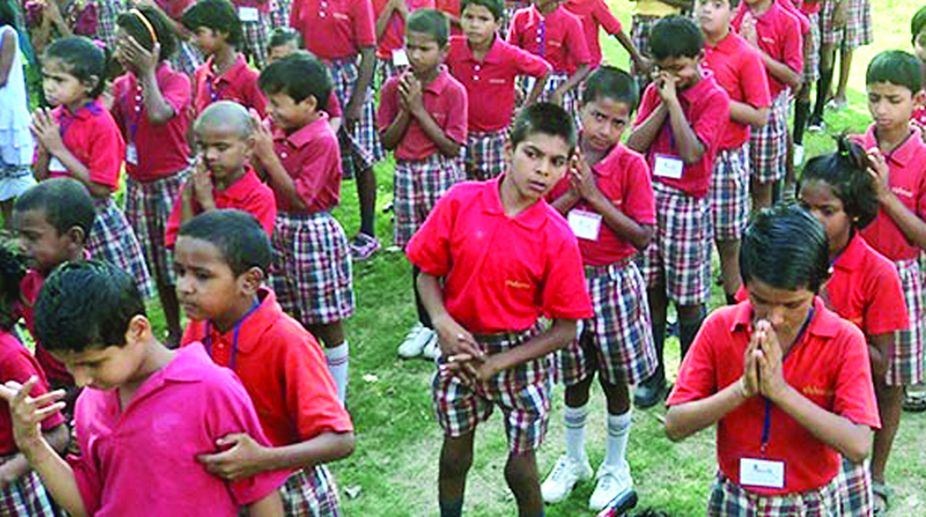With the government flagging off the Sarva Shiksha Abhiyan, which bars schools from rejecting children on the basis of physical or mental disability, a teacher’s role in a student’s life is challenging.
Children born with disabilities are so “special” that a person working for them has to understand and comprehend situations as well as people. Every child with a special need is different and so we have to understand the level of need for each child and devise a specific method.
Advertisement
Also, it is quite difficult to fathom the level of mental challenge in them. We generally look at just the tip of the iceberg; we really need to go deeper and read their minds.
Things are more complicated with children who have specific learning disabilities, such as dyslexia or dysgraphia (inability to write coherently). This is because their special need is not so obvious. the condition manifests only when academic pressure increases in school and the child fails to cope with it.
Many children, who have special educational needs, have no visible disability. They do have specific difficulties in reading, writing, spelling and mathematics, and they find it difficult to cope with a textbook-based syllabus.
Some have serious difficulties in adjusting with the norms and conventions of school, resulting in occasionally weird behaviour. It needs to be underlined that these children are not ignored or they do not simply drop out of mainstream education.
It has been noticed that by and large when students are referred for external help , they are already fragile. Many develop low self-esteem ; some have examination phobia or psychosomatic conditions like nausea and migraine. Children diagnosed with what they call “challenging behaviour” are perhaps worse off than those who have difficulties in learning.
Once a child has been regarded as disruptive, even small acts of mischief assume larger proportions. They are usually teased by the peers who use their names as a cover for their own misdemeanors. This leads to a cynical flow of challenging behaviour on their part and further challenges on our part.
Sometimes these children are also punished, an action that serves to reinforce the very behaviour that it seeks to correct. When Ishan, the character in Tare Zameen Par is thrown out of class, he spends his time wandering around and enjoys himself in his own way.
In Black, which was based on the life of the legendary author-activist Helen Keller and her teacher Anne Sullivan, Debraj teaches Michelle, albeit painstakingly, spelling the words through his fingers on her palm.
Encouragingly, however, the films such as Margharita, Iqbal and My Name is Khan helped spread awareness about children with special needs.
‘Inclusive education’ implies a system of education that is progressive and flexible enough to meet the diverse needs of all students including those with disabilities. Inclusion is an ongoing process of school reform that may be beneficial for all students irrespective of being bright or having special educational needs.
However, it must be ensured that children with special needs gain equal access to the curriculum and that school authorities be dissuaded from making unjust and, sometimes, insensitive decisions.
The teacher is not just a teacher here; he has to play the role of a counsellor, friend and family member. He has to build a relationship of trust and motivate and be more innovative as the degree of disability is not the same in all students. With a well-planned educational structure, patience and bond of affection, he has to bring out the best in a “special child”.
To avoid any sort of bullying by mates, the special needs child must be taken care of. The teacher should set common rules for the entire class and never let them feel inferior to others. Regular communication with parents of these children is necessary because some parents may feel that their wards are not valued as they are challenged.
Contact with parents will ensure their support to the teachers in helping the children deal with their disability. It is important that their areas of interest and their excellence in that field be recognized so that they could be encouraged in those areas.
The teacher should be involved in student activities and monitor their independent interests. He should assign individual activities to them in the classroom and supervise them in a subtle manner so that “special-needs children”, so-called, know that they are being treated equally. In this way their self-confidence may also be enhanced. They should feel free to talk to the teacher about their problems.
With training and will-power, all schools can be inclusive so that children with special educational needs feel secure and thus be properly educated.
A school is established for all children. It is meant to be a safe haven where children, in general, feel that they are looked after and wanted, for the institution symbolizes tolerance, inclusion and acceptance.
The school is expected to be equipped with facilities to deal with diversity and also to create confident individuals capable of making informed choices with the skill to evaluate the implications of these decisions.
The so-called “special needs education” is challenging but can be immensely satisfying. Only compassionate people with a sincere desire to give a new direction to the lives of children with special needs can afford to accept the challenge of constantly assessing a child, tweak his teaching accordingly and monitor progress.
Of course, the work is time-consuming and the result, at times, extremely frustrating. But with a little patience and zeal, a new lease of life to a “special child” can literally be given.
The writer is former Associate Professor, Department of English, Gurudas College, Kolkata











